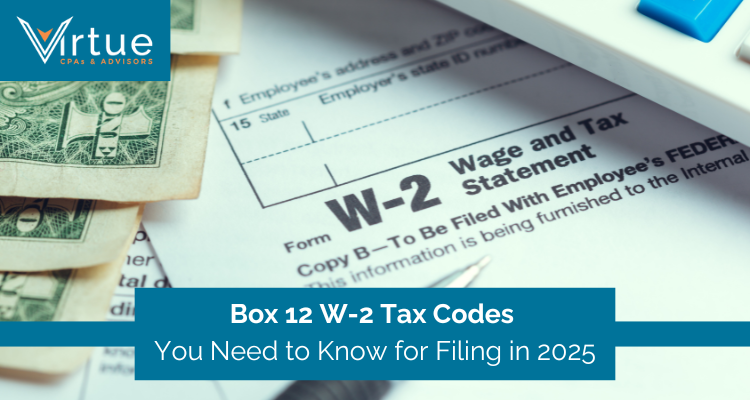Staring at your W-2 form and wondering what those cryptic Box 12 codes mean? You're not alone. Box 12 contains some of the most critical—and often misunderstood—information on your entire W-2 form. These codes directly impact your tax liability, potential deductions, and compliance obligations.
Here's what you need to know immediately: Box 12 uses letter codes (A through Z, plus double letters like AA, BB, DD) to report various types of compensation, benefits, and deductions that don't fit in other W-2 boxes. Some codes save you thousands in taxes, while others indicate additional taxable income you must report.
For law firm partners, CFOs, and business professionals, understanding these codes isn't just about personal tax filing—it's about strategic tax planning, compliance management, and optimizing your overall compensation structure.
What Are W-2 Box 12 Codes, and Why Do They Matter?
Box 12 on Form W-2 reports about certain types of compensation, benefits, and deductions using standardized letter codes. Think of it as the "everything else" section that captures important tax information that doesn't fit in the standard wage and withholding boxes.
Each code tells a specific financial story about your employment relationship, from retirement contributions that reduce your current taxes to employer-provided benefits that might increase your taxable income.
Why Box 12 codes matter for professionals:
- Immediate tax impact: Some codes reduce current year taxable income by thousands
- Compliance requirements: Incorrect reporting triggers IRS matching program alerts
- Strategic planning opportunities: Understanding codes helps optimize future tax strategies
- Audit prevention: Proper reporting prevents costly IRS correspondence and penalties
For law firm partners and business owners, Box 12 codes become even more complex when combined with partnership distributions, business income, and sophisticated benefit packages.
How Do I Read My W-2 Box 12 Codes?
Box 12 is divided into four subsections: 12a, 12b, 12c, and 12d. Each subsection shows a letter code on the left and the corresponding dollar amount on the right, separated by a vertical line.
Reading format example: If you see "D | 20000" in Box 12a, this means you contributed $20,000 to your 401(k) plan during the tax year.
Important formatting rules:
- Single letter codes (A through Z) for most common items
- Double letter codes (AA, BB, DD, etc.) for newer or specialized items
- If you have more than four reportable items, your employer issues additional W-2 forms
- Codes must be reported exactly as shown—case sensitivity matters for tax software
W-2 Box 12 Codes: Full List and Their Meanings
1. Single Letter Codes (A-Z)
Code A: Uncollected Social Security Tax on Tips Reports Social Security tax on tip income that your employer couldn't collect from regular wages. You must pay this tax when filing your return.
Code B: Uncollected Medicare Tax Tips Shows Medicare tax on tip income that wasn't withheld from your paycheck. Must be paid with your tax return.
Code C: Taxable Cost of Group-Term Life Insurance Over $50,000 Reports taxable income from employer-provided life insurance coverage exceeding $50,000. Increases your taxable income based on IRS premium tables.
Code D: 401(k) Plan Contributions Shows your pre-tax contributions to employer-sponsored 401(k) plans. Reduces current taxable income dollar-for-dollar.
Code E: 403(b) Plan Contributions Reports contributions to 403(b) retirement plans, typically for non-profit organizations and educational institutions.
Code F: SEP Plan Contributions Shows contributions to Simplified Employee Pension (SEP) plans, common in small businesses and professional practices.
Code G: 457(b) Plan Contributions Reports contributions to 457(b) deferred compensation plans, primarily for government and non-profit employees.
Code H: 501(c)(18)(D) Plan Contributions Shows contributions to rare tax-exempt organization plans established before 1959. Most have been converted to other plan types.
Code J: Nontaxable Sick Pay Reports sick pay benefits that are not subject to income tax, typically from third-party insurance policies.
Code K: 20% Excise Tax on Excess Golden Parachute Payments Shows excise tax on excessive severance payments to highly compensated executives.
Code L: Substantiated Employee Business Expense Reimbursements Reports reimbursements for legitimate business expenses with proper documentation.
Code M: Uncollected Social Security Tax on Group-Term Life Insurance Shows Social Security tax on life insurance benefits that couldn't be collected from wages.
Code N: Uncollected Medicare Tax on Group-Term Life Insurance Reports Medicare tax on life insurance benefits that wasn't properly withheld.
Code P: Excludable Moving Expense Reimbursements (Armed Forces) Shows qualified moving expense reimbursements for military personnel only (post-2017 tax law changes).
Code Q: Nontaxable Combat Pay Reports combat pay that military personnel can elect to include in earned income for certain tax benefits.
Code R: Archer MSA Contributions Shows employer contributions to Archer Medical Savings Accounts (predecessor to HSAs).
Code S: SIMPLE Plan Salary Reduction Reports salary reduction contributions to SIMPLE IRA or 401(k) plans.
Code T: Adoption Benefits Shows employer-provided adoption assistance up to annual exclusion limits.
Code V: Non statutory Stock Option Income Reports taxable income from exercising nonqualified stock options.
Code W: Health Savings Account (HSA) Contributions Shows employer contributions to your HSA. Tax-free but counts toward annual contribution limits.
Code Y: Section 409A Deferrals Reports deferrals under nonqualified deferred compensation plans meeting Section 409A requirements.
Code Z: Section 409A Income Shows income from nonqualified deferred compensation plans that fail Section 409A compliance.
2. Double Letter Codes (AA-HH)
Code AA: Roth 401(k) Contributions Shows after-tax Roth contributions to 401(k) plans. No current tax deduction but tax-free retirement withdrawals.
Code BB: Roth 403(b) Contributions Reports after-tax Roth contributions to 403(b) plans for eligible employees.
Code DD: Employer-Sponsored Health Coverage Cost Shows total cost of employer-provided health insurance (informational only, not taxable).
Code EE: Roth 457(b) Contributions Reports Roth contributions to governmental 457(b) plans.
Code FF: Small Employer Health Reimbursement Arrangement Shows benefits under qualified small employer health reimbursement arrangements (QSEHRAs).
Code GG: Qualified Equity Grant Income Reports income from qualified equity grants under Section 83(i) deferral elections.
Code HH: Aggregate Section 83(i) Deferrals Shows total deferrals under Section 83(i) elections for qualified equity grants.
Code II: Medicaid waiver payments that are excluded from gross income, as outlined in IRS Notice 2014-7.
Box 12 Codes by Category: Understanding Tax Impact
1. Retirement and Deferred Compensation Codes
| Code | Plan Type | Current Tax Impact | 2025 Limits |
|---|---|---|---|
| D | 401(k) Traditional | Reduces taxable income | $23,500 ($31,000 if 50+) |
| E | 403(b) Traditional | Reduces taxable income | $23,500 ($31,000 if 50+) |
| F | SEP | Reduces taxable income | Lesser of 25% or $70,000 |
| G | 457(b) | Reduces taxable income | $23,500 ($31,000 if 50+) |
| S | SIMPLE | Reduces taxable income | $16,500 ($20,000 if 50+) |
| AA | Roth 401(k) | No current reduction | $23,500 ($31,000 if 50+) |
| BB | Roth 403(b) | No current reduction | $23,500 ($31,000 if 50+) |
2. Health and Insurance Benefits
- Code C (Life Insurance): Increases taxable income for coverage over $50,000
- Code W (HSA): Tax-free employer contributions, limits: $4,600 individual/$9,200 family
- Code DD (Health Coverage): Informational only, shows total premium costs
- Code FF (QSEHRA): Tax-free small employer health reimbursements
3. Stock and Equity Compensation
- Code V (Stock Options): Taxable income from nonqualified stock option exercises
- Code GG (Equity Grants): Income from Section 83(i) qualified equity grants
- Code HH (Deferrals): Aggregate deferrals under Section 83(i) elections
What Box 12 Codes Mean for Law Firm Professionals
Law firm partners and employees face unique Box 12 situations due to complex compensation structures, partnership distributions, and specialized benefit arrangements.
Common scenarios for legal professionals:
- Partnership track compensation: Deferred compensation arrangements affecting Codes Y and Z
- Equity partnerships: Stock option-like arrangements creating Code V situations
- Premium benefit packages: Multiple codes for health, life, and disability coverage
- Professional liability coverage: Specialized insurance arrangements
Strategic considerations for law firms:
- Coordinating Box 12 items with partnership K-1 distributions
- Timing stock option exercises to optimize tax brackets
- Maximizing retirement contributions while managing partnership income
- Structuring compensation to optimize both personal and firm tax positions
What's New for 2025: Important Updates and Changes
Several significant changes affect Box 12 reporting for 2025:
Increased Contribution Limits
- 401(k) and 403(b) deferrals rise to $24,000 (up from $23,000)
- Catch-up contributions increase to $7,500 for those 50 and older
- SIMPLE plan limits increase to $16,500 ($20,000 with catch-up)
- HSA limits rise to $4,600 individual/$9,200 family
Enhanced IRS Matching Programs: The IRS has strengthened automated cross-referencing between employer Box 12 reporting and individual tax returns. This makes accuracy more critical than ever.
New Section 409A Enforcement: Stricter oversight of nonqualified deferred compensation plans affects Codes Y and Z reporting, particularly important for high-earning professionals and executives.
Updated Stock Option Rules: Changes in Section 83(i) regulations impact Codes GG and HH reporting for equity compensation arrangements.
Box 12 Common Mistakes That Might Cost You Money
1. Retirement Contribution Overages
The most expensive mistake: Contributing more than annual limits across multiple retirement accounts. This triggers immediate IRS correspondence and requires corrective distributions.
Example: A law firm partner contributes $24,000 to their firm's 401(k) but forgets about a previous employer's plan where they contributed $5,000 earlier in the year. The $5,000 excess triggers penalties and complex corrective procedures.
2. HSA Contribution Coordination Errors
Double-dipping dangers: Not coordinating employer HSA contributions (Code W) with personal contributions leads to excess contribution penalties of 6% annually until corrected.
3. Ignoring Uncollected Tax Codes
Costly oversight: Codes A, B, M, and N represent taxes you still owe. Ignoring these codes means underpaying your tax liability and facing penalties plus interest.
Strategic Planning with Box 12 Codes
1. Year-Round Optimization
Box 12 planning shouldn't wait until tax season. Successful professionals monitor these codes quarterly to optimize tax strategies and ensure compliance.
Quarterly checkpoints:
- Q1: Review previous year actuals and set current year targets
- Q2: Mid-year adjustment opportunities for contribution timing
- Q3: Strategic planning for year-end moves and elections
- Q4: Final optimization and next year planning
2. Integration with Business Planning
For law firm partners and business owners, Box 12 optimization must coordinate with:
- Partnership K-1 distributions and timing
- Business income projections and tax planning
- Estate planning and wealth transfer strategies
- Succession planning and ownership transitions
3. Advanced Strategies
Multi-year tax planning considers how Box 12 items affect not just the current year but future tax situations, especially important for:
- Roth conversion strategies
- Stock option exercise timing
- Deferred compensation elections
- Retirement distribution planning
Take Control of Your Box 12 Strategy Today
Don't let Box 12 codes remain a mystery that costs you money. Understanding these codes empowers better tax planning, ensures compliance, and can save thousands annually through strategic optimization.
The complexity of Box 12 reporting makes professional guidance essential for law firm partners, business owners, and high-earning professionals who want to maximize their tax efficiency while maintaining full compliance.
At Virtue CPAs, see how our Monthly Accounting Services, Business Consulting Services, and CFO/Controller Services create seamless financial management that optimizes your entire operation.






